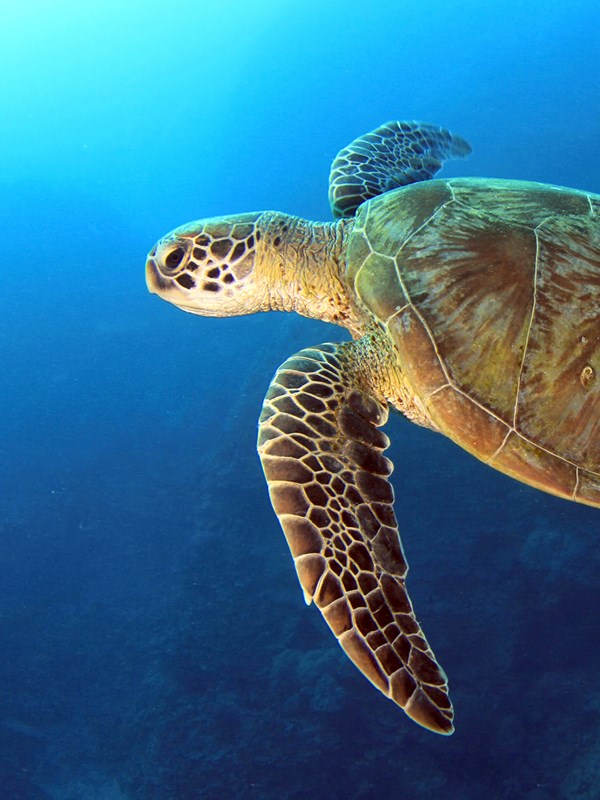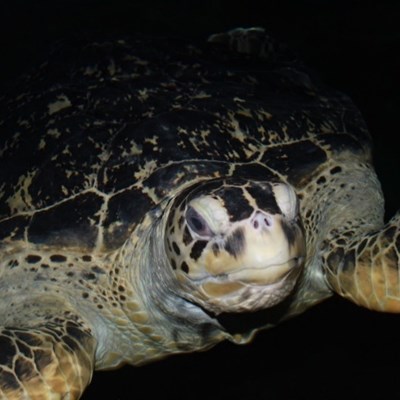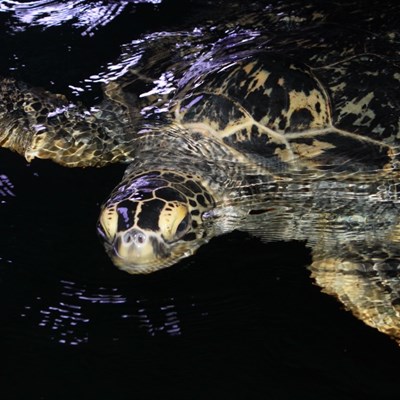
Green Sea Turtle
Scientific Name Chelonia mydas
Native To Tropical and subtropical oceans around the world
Habitat Open ocean and coastal waters
Diet Omnivore: sea weed, jellyfish, invertebrates and algae
Size and Age Up to 1.22 m (4 ft) long and 150 kg (330 lbs); average lifespan of 60-80 years
Natural History
- Green sea turtles are solitary for most of their lives, but congregate during mating season. Males and females of this species look identical until they reach sexual maturity (around 25-50 years old). Once mature, males have a longer tail and carapace, with mating claws that develop on the edge of their front flippers.
- Females will return to the same beach each year to lay their eggs, sometimes travelling thousands of kilometers to reach their spawning grounds. Because of the physical demand of travelling to distant beaches, female sea turtles will not reproduce every year. Instead they will breed only when their fat reserves are large enough to accommodate travel, sometimes between 2-4 years apart.
- Once hatched, green sea turtles must fight their way from their beachside nests to the sea. In doing so, they face predators from both land and sea. Out of the approximately 1,000 eggs laid, in several nests, only one hatchling will make it to adulthood.
- Young sea turtles start on a diet consisting of mainly jellyfish and invertebrates. As they grow older and larger, they switch their diet to seaweed and algae. Green sea turtles grow very slowly, taking over 20 years to reach their full size.
Endangered

Conservation Status
Green sea turtles are listed as endangered by the International Union for Conservation of Nature (IUCN). As a species, they face several threats:
- Marine debris (mostly plastics) from human pollution can get tangled around sea turtles, or it can be ingested and cause an impaction.
- While migrating through commercial fishing zones, sea turtles are accidentally captured, injured or killed by fishermen.
- Human alteration of coastlines from building and development forces nesting females to use other beaches. This changes the properties of their nesting beaches, and contributes to the pollution of sea turtle habitats.
- Sea turtle hatchlings are guided to the ocean, at night, by the natural light on the ocean horizon. Beachfront lighting disorients hatchlings when they emerge from their nests, leading them away from the water and towards roads and buildings.
- Hunting by humans for their meat, eggs, and shells.
Interesting Facts
- Green sea turtles are the largest hard shell turtle species (although the leatherback sea turtle is larger, it has a soft shell).
- They get their name from the color of their fat, which turns green from the sea weed and algae that they eat.
- The gender of baby sea turtles is based on the temperature of their nests—lower temperatures produce males, while higher temperatures produce females.
- They can hold their breath for up to 5 hours when resting or sleeping, by slowing down their heart rate as low as 1 beat every 9 minutes to conserve oxygen.
- Because sea turtles live in salt water, they end up ingesting salt as they eat. To remedy this, they have a special gland behind their eyes that pulls salt out of water, allowing them to excrete unwanted salt.
Our Turtles

Donatello
Donatello is the smallest of Marine Life’s sea turtles. He was rescued by Fish & Wildlife from the spare tire compartment of a car in 1988, after an attempt to smuggle him across the border.
His current age estimate is around 36 yrs old (as of 2017). Donatello is target trained to come to the surface for husbandry (medical and health) behaviors, and his favorite treat in training sessions is squid.

Blue
Blue was born at the Cayman Island Turtle Farm in 1996, then moved to the University of British Columbia. Here he and his brother Mini participated in a study helping biologists learn more about green sea turtle physiology. When they became too big for their enclosures, they were donated to Marine Life.
Blue’s coloration looks very similar to Donatello, but he is larger in size. He also has squinted eyes, whereas Donatello’s are large and round. Blue is very calm, and is a fast learner in underwater training sessions with Marine Life scuba divers.
